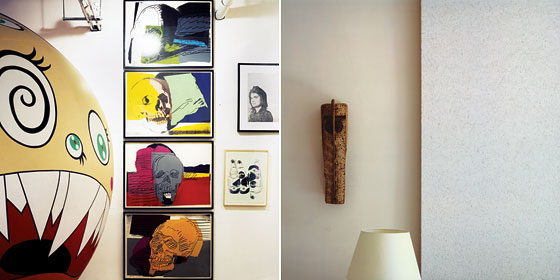
At a 2007 Guggenheim panel, Richard Prince declared, “It was my job to, kind of, shoot the sheriff,” presumably implying that he was the slayer of photography, unmasking the grammar of images. But these aesthetic elements were caught in a crossfire in the seventies; what happened wasn’t the work of a lone gunman, and one of the sharpest shooters of all was Louise Lawler.
A saboteur in the house of art and a comedienne in the house of art theory, Lawler has spent three decades documenting the secret life of art. Functioning as a kind of one-woman CSI unit, she has photographed pictures and objects in collectors’ homes, in galleries, on the walls of auction houses, and off the walls, in museum storage. All the while, she’s revealed how the installation of artworks is never neutral. Lawler photographed Jasper Johns’s White Flag hanging over a collector’s bed, Jeff Koons’s $80 million Rabbit near someone’s refrigerator, a woman casually gesturing with a Picasso sculpture in hand, a Gerhard Richter nude resting on its side on a museum floor, and Warhols galore in auction houses, art fairs, apartments, and galleries.
To see a Delaunay crowded behind a TV, a Warhol “Green Stamps” painting on a hideous red wall, or an extraordinary Mondrian behind an armchair is like seeing how meat is processed. Lawler also comments on the male dominance of art history; a black-and-white picture, taken at the Met, of a statue of Perseus with the head of Medusa is cropped exactly at the penis. She’s even taken pictures of her own pictures in museums (seeing a Lawler by Lawler is uncanny).
Lawler’s sweet but lethal arsenic-and-old-lace documentary photography pulls you in, then makes you squirm. The more you know about her photos—what is pictured, where it’s housed, what it costs—the more you’re implicated. It’s her way of talking back, laughing last, and doing a little consciousness-raising. You look at a Lawler with a combination of unease, incredulity, scorn, and glee.
Lawler has also turned out a line of multiples, a sort of Louise Lawler Home Collection—napkins for MoMA, stationery for Documenta, paperweights, matchbooks. Like the photos, these objects make wry jokes about consumption, materialism, and art-world peccadilloes. In 1972, she made a hilarious recording of herself doing birdcalls satirizing the names of famous male artists, screeching and chirping “Donald Judd,” “Vito Acconci,” “Anselm Kiefer.” It’s been nicknamed the “Patriarchal Roll Call.”
Lawler is one of the least obtrusive great artists of our time. Her art has barely changed in twenty years, yet it’s still breezy and mean, simultaneously institutional critique and guilty pleasure, the airing of our dirty laundry and an exercise in superior observation. For her ninth solo show at Metro Pictures since 1982, Lawler is doing what she’s always done, and as well as she’s ever done it, maybe better: taking us into the deepest, darkest, most expensive heart of the art world. Her exhibition is as filled with covetousness, cravenness, and sexism as Girls Gone Wild, with Lawler as the crafty camera operator coaxing institutions to “Show us your tits.”
For this show, she photographed art by Richter, Lichtenstein, Ryman, Serra, Martin, and Flavin as it sat at auction houses. All this art looks forlorn as it awaits its fate. Some of these images are overexposed, as if that’s what’s happening to this work. In the largest gallery, we see Koons and more Koons, Warhol upon Warhol, Murakami and Ruscha, all the male market titans. Several of these images were taken in the Los Angeles County Museum of Art’s Broad Contemporary Art Museum. The way these blue-chippers fill this glitzy new building is as atrocious as an auction house. In the final gallery, we’re ushered into the home of Claude Berri, the French filmmaker known for turning dramatic situations humorous and vice versa. In one picture we see the left side of a white Ryman painting near an African mask; in another we see the other half of the same painting next to another mask. It’s a picture of refinement and a wry way of showing how we package our own taste. In each of the three galleries, there’s an image of Maurizio Cattelan’s large sculpture of an elephant under a white sheet overlaid with the words IRAQI OIL in faint letters. It’s a perfect metaphor for the way in which art—including Lawler’s, which also sells quickly for high prices to trophy-hunters—has become part of a larger economic machine.
One thing Lawler never gets credit for is how captivating and strange her pictures are as photographs. In some ways Lawler is a conceptual Diane Arbus. She’s a stalker who takes advantage of situations. She pulls back curtains, causing normal things to look freakish and the freakish to turn mundane. Like Arbus, Lawler is a confident contrarian with no sentimentality—but an endless love for and a fetishistic interest in her subject.
Louise Lawler
Metro Pictures.
Through June 7.
E-mail: jerry_saltz@newyorkmag.com.